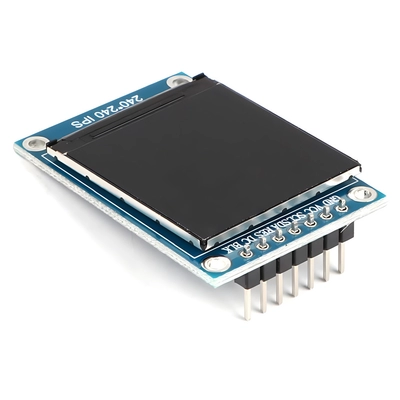Understanding TFT LCD Interface Options with STM32
Before making any connections, you need to determine your TFT LCD’s interface type. Common options include:
- Parallel (8080/6800 bus) – Requires multiple data and control lines, fast speed, ideal for larger displays.
- SPI interface – Fewer pins required, ideal for resource-limited projects or small displays, but slightly slower.
- RGB interface – Outputs pixel clock and RGB data lines directly, used for high-refresh applications.
Tip:
For beginners, an SPI TFT LCD is often the easiest choice because most STM32 MCUs support hardware SPI, making wiring and coding simpler.
Hardware Connections and Power Design
To drive a TFT LCD, you’ll typically need three types of power supply:
- Logic Voltage (VCC)
- Commonly 3.3V; some older modules may require 5V logic.
- Ensure the STM32 I/O voltage matches the LCD’s logic level. If not, use a level shifter (e.g., 74HC245, TXB0108).
- Backlight Power (LED+ / LED-)
- Small displays often use LED strings for backlight, requiring between 3V–12V.
- Use a constant-current driver or MOSFET with PWM control for brightness adjustment.
- GND Ground
- All grounds must be connected to avoid flickering or unstable operation.
Extra Notes:
- Add decoupling capacitors (0.1µF + 10µF) near the VCC pin for stability.
- Route the backlight power separately from logic signals to minimize noise interference.
Backlight Control – The Key to a Bright Display
Even if the logic section initializes successfully, the screen will appear blank if the backlight isn’t powered.
STM32 Backlight Control Options:
- Use a GPIO pin to drive a MOSFET on/off switch for the backlight.
- Use a timer’s PWM output to adjust brightness (recommended). A PWM frequency between 1kHz–20kHz avoids visible flicker.
Example wiring:
STM32 TIMx_CHy → MOSFET Gate → LED+ (through constant current driver or resistor)Software Initialization Process
The heart of driving a TFT LCD is sending the correct initialization commands to its controller. Let’s take the ILI9341 controller as an example.
- Hardware Reset
- Pull RESET low for at least 10ms, then pull high and wait for stabilization.
- SPI/Parallel Configuration
- For SPI, set 8-bit data mode and a clock frequency around 10–20MHz (lower if long cables are used).
- Send Initialization Commands
- Follow the controller’s datasheet sequence (pixel format, display direction, gamma settings, etc.).
- Fill the Screen
- Test with solid color fills (white, black, red, green, blue) to verify proper operation.
Basic Example Code (SPI + ILI9341)
void ILI9341_Init(void) {
HAL_GPIO_WritePin(RESET_GPIO_Port, RESET_Pin, GPIO_PIN_RESET);
HAL_Delay(10);
HAL_GPIO_WritePin(RESET_GPIO_Port, RESET_Pin, GPIO_PIN_SET);
HAL_Delay(120);
ILI9341_SendCommand(0xEF);
ILI9341_SendData(0x03);
ILI9341_SendData(0x80);
ILI9341_SendData(0x02);
// More initialization commands...
ILI9341_SendCommand(0x29); // Display ON
}Common Issues and Troubleshooting
Display stays white or black
- Check power connections and confirm the backlight is enabled.
Flickering or distorted images
- Shorten cable length or reduce SPI/parallel clock speed.
Incorrect colors
- Verify pixel format settings (RGB565 vs RGB666).
Pro Tips for Better Performance
- Use DMA transfers to speed up drawing and reduce CPU usage.
- For larger displays, consider STM32’s FSMC or LTDC peripheral for RGB interface.
- In noisy environments, add shielding or EMI filters to signal lines.
Final Thoughts
Lighting up a TFT LCD with STM32 is all about balancing hardware design and software configuration. By understanding the interface type, matching voltage levels, and following the correct initialization sequence, you can bring vibrant graphics to life in your embedded projects.
For beginners, start with a small SPI display and work your way toward more complex interfaces like parallel or RGB.

